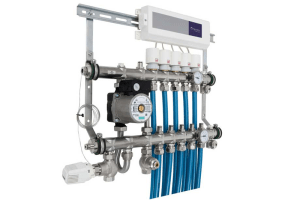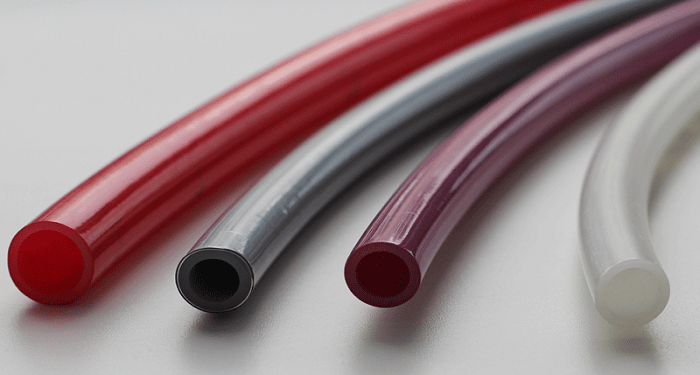At the very beginning of construction or renovation, people often think about changing the heating system. A good solution is an infrared warm floor or a heating cable, thanks to which heat appears through electricity. This allows you to improve the heating of the premises, saves money with the help of a warm floor and space. Water-heated floors have a complex design, but it is possible to carry out the system with your own hands if you know the features, rules, and stages of implementation.
Water floor device
A warm water floor has the following main elements:
- Pipes
- Collector
- Heat insulator.
It is recommended to use pipes of 2 cm in diameter made of polyethylene. Experts recommend using a material with an anti-oxygen coating. It is better to buy synthetic pipes, because the installation of a water-based warm floor will be easier, and due to the internal smoothness, corrosion and obstacles do not occur.
The main part of the entire structure is the collector. On sale there are ready-made systems with convenient cabinets for installation, such a solution is optimal if you make a warm water floor with your own hands.

The main thing to know is the number of pipe inlets and outlets, the equipment itself is selected based on their number. New collectors may include the following additions:
- Pressure stabilizers.
- Pumps
- Temperature regulators.
- Outputs for connecting several heating devices with different temperatures at once.

Do-it-yourself heated floors must include a heat-insulating layer – a prerequisite.
Under the pipes, the material is laid butt, using foam or high-density polystyrene up to 5 cm thick. After that, a film for thermal insulation, a water barrier, is applied. The coating prevents heat loss through the concrete floors between the floors pklikes.com
Types of underfloor heating systems
There are 3 main types of water warm floor:
- Classic – with the help of a boiler, water is heated and circulates in the pipes, heating the room.
- Electro-water – a heating cable is used, which is mounted inside the pipe.
- Floor system – an electrical system used for installation under parquet, wooden floor, or linoleum.
Classic
The standard version of warm radiant floors implies the installation of pipes into which water is introduced. With the help of a boiler or central heating, it warms up and heats the room. Classic warm water floor is used most often, because the system is universal and easy to install, before the start of construction or during planned repairs. The connection of the system is free, it allows you to make autonomous heating in the apartment, which will save money.
The main characteristics are as follows:
- Ease of installationin a house, cottage, or apartment. In the latter case, the connection is possible only to heat exchange nodes that are already there, while the integrity of the system for the whole house should not be violated.
- It can be installed in rooms with wooden furniture. The outgoing heat does not cause it to dry out.
- Water underfloor heating is safe, the pipes do not deteriorate over the years, and they do not collect harmful particles that can reduce the internal diameter.
The water-warm floor device has 2 types:
- Concrete screed is a common option, when pipes are filled with concrete, which eliminates the need for an additional heat distributor.
- Polystyrene system – polystyrene plates are used, which have aluminum parts, and a pipe is laid on them. It is recommended to use only in rooms with low ceilings or in buildings with weak floors to reduce the load on the ceiling.
Main advantages:
- Compatible with any kind of floor finish, can be used under linoleum, carpets, laminate, or tiles.
- A water warm floor is easily installed independently, does not cause large costs.
- The autonomy of the system allows you to independently regulate the heat and save money.
- You can refuse electric heating completely.
- Boilers can work without electricity if equipment is used on wood or coal.
Disadvantages include the fact that in high-rise buildings, construction is prohibited due to a possible breakthrough and flooding of neighbors.
Electro-water
The system does not require the use of a boiler, because it is a floor with water heating, which has heating elements installed in the pipes. For work, you will need to connect to electricity, but you do not need to use pumps. Water does not circulate, it remains in place, heating begins as a result of the operation of the heating element.
Installation materials are sold in bulk. A person buys pipes with a heating part and a special substance inside that replaces water. This design has maximum autonomy and ease of use. The electric warm water floor has the following advantages:
- For heating, a minimum amount of liquid is used, which can be adjusted with a thermostat for underfloor heating.
- The heating is uniform along the entire perimeter, which will allow you to heat the room in its entirety, and not its separate parts, as in the case of the classic version.
- In A large list of settings, you can choose a separate part of the pipes for heating.
Installation of a warm water floor with an electric element inside can be carried out in a multi-story building. Risks of breakthrough and flooding are excluded.
Conclusion
It is difficult to explain all the features in one article, but the main characteristics and installation methods become clear after reading. Any process can be done independently, but it is better to entrust warm water floors according to the classic or electric scheme to masters who will not allow mistakes and problems in the operation of the system in the future. The choice of the type of construction depends on the specific house, financial capabilities, and needs of the person.













